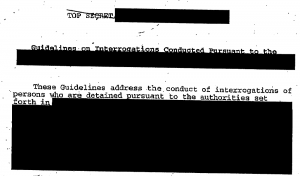Michael Hayden, Privacy and Counterterrorism Frugality Champion
Of 1,423 words in an article questioning whether deficit hawkery might cut the domestic spying budget, Scott Shane devotes over a sixth–roughly 260–describing what former NSA and CIA Director Michael Hayden thinks about the balances between funding and security.
Remarkably, none of those 260 words disclose that Hayden works for Michael Chertoff’s consulting group, which profits off of big domestic spying. This, in an article that cites Chertoff’s electronic border fence among the expensive counterterrorism duds that were subsequently shut down (Shane mentions “puffer” machines as well, but not the Rapiscan machines that Chertoff’s group lobbied for, which are now being withdrawn as well).
And then there’s a passage of Shane’s article that touches on topics in which Hayden’s own past actions deserve disclosure.
Like other intelligence officials after 2001, Mr. Hayden was whipsawed by public wrath: first, for failing to prevent the Sept. 11 attacks, and then, a few years later, for having permitted the National Security Agency to eavesdrop on terrorism suspects in the United States without court approval.
Perhaps, as a result, he often says that the American people need to instruct the government on where to draw the line. He told an audience at the University of Michigan last month, for instance, that while a plot on the scale of the Sept. 11 attacks was highly unlikely, smaller terrorist strikes, like the shootings by an Army psychiatrist at Fort Hood in Texas in 2009, could not always be stopped.
“I can actually work to make this less likely than it is today,” Mr. Hayden said. “But the question I have for you is: What of your privacy, what of your convenience, what of your commerce do you want to give up?”
To be fair, Shane counters Hayden’s claims by noting that “secrecy … makes it tough for any citizen to assess counterterrorism programs.”
But he doesn’t mention one of the biggest examples where Hayden–where anyone–chose both the most expensive and most privacy invasive technology: the wiretap program Hayden outsourced to SAIC rather than use in-house solutions.
As Thomas Drake has made clear, by outsourcing to SAIC, Hayden spent 300 times as much as he would have with the in-house solution.
One of them was Lieutenant General Michael Hayden, the head of the agency: he wanted to transform the agency and launched a massive modernization program, code named: “Trailblazer.” It was supposed to do what Thin Thread did, and more.
Trailblazer would be the NSA’s biggest project. Hayden’s philosophy was to let private industry do the job. Enormous deals were signed with defense contractors. [Bill] Binney’s Thin Thread program cost $3 million; Trailblazer would run more than $1 billion and take years to develop.
“Do you have any idea why General Hayden decided to go with Trailblazer as opposed to Thin Thread, which already existed?” Pelley asked.
[snip]
Asked to elaborate, Drake said, “Careers are built on projects and programs. The bigger, the better their career.” [my emphasis]
Along the way, Hayden repeatedly blew off Congressional staffer Diane Roark’s inquiries about privacy protection.
When Binney heard the rumors, he was convinced that the new domestic-surveillance program employed components of ThinThread: a bastardized version, stripped of privacy controls. “It was my brainchild,” he said. “But they removed the protections, the anonymization process. When you remove that, you can target anyone.” He said that although he was not “read in” to the new secret surveillance program, “my people were brought in, and they told me, ‘Can you believe they’re doing this? They’re getting billing records on U.S. citizens! They’re putting pen registers’ ”—logs of dialled phone numbers—“ ‘on everyone in the country!’ ”
[snip]
[Former HPSCI staffer Diane Roark] asked Hayden why the N.S.A. had chosen not to include privacy protections for Americans. She says that he “kept not answering. Finally, he mumbled, and looked down, and said, ‘We didn’t need them. We had the power.’ He didn’t even look me in the eye. I was flabbergasted.” She asked him directly if the government was getting warrants for domestic surveillance, and he admitted that it was not. [my emphasis]
So it’s not just disclosure of all the ways Hayden has and does profit off of continued bloated domestic surveillance that Shane owes his readers: he also should refute Hayden’s claims about the relationship between cost, privacy, and efficacy.
Michael Hayden’s SAIC-NSA boondoggle is one case where secrecy no longer hides how much money was wasted for unnecessary privacy violations.
Yet somehow, that spectacular example of the unnecessary waste in domestic spying doesn’t make it into the 260 words granted to Hayden to argue we need continued inflated spending.

